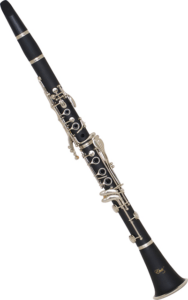Clarinet Rental Online

Clarinet Rentals
- 25% discount for 10 month prepayment clarinet rentals.
- Professionally checked, adjusted and lubricated for the best performance.
- Our clarinet rentals Include clarinet, case, 1 2.0 strength reed, cleaning swab, cork grease and name tag.
- Our clarinet rental program serve Fairfax, Centreville, Bristow, Chantilly, Sterling, Manassas, Haymarket, Clifton, Vienna, Gainesville, Oakton, and South Riding. Please check our website and do not hesitate to contact us if you have any questions.
- Free loaner or same day exchange when the servicing is needed.
- We started clarinet rental program in 2007. We do the maintenance and service in house.
The clarinet is a single-reed musical instrument in the woodwind family, with a nearly cylindrical bore and a flared bell.
Clarinets comprise a family of instruments of differing sizes and pitches. The clarinet family is the largest woodwind family, ranging from the BB♭ contrabass to the E♭ soprano. The B♭ soprano clarinet is the most common type, and is the instrument usually indicated by the word “clarinet”.
German instrument maker Johann Christoph Denner is generally credited with inventing the clarinet sometime after 1698 by adding a register key to the chalumeau, an earlier single-reed instrument. Over time, additional keywork and airtight pads were added to improve the tone and playability. Today the clarinet is a standard fixture of the orchestra and concert band and is used in classical music, military bands, klezmer, jazz, and other styles.
Etymology
The word clarinet may have entered the English language via the French clarinette (the feminine diminutive of Old French clarin), or from Provençal clarin (“oboe”),[1] originating from the Latin root clarus (“clear”).[2] The word is related to Middle English clarion, a type of trumpet, the name of which derives from the same root.[3]
The earliest mention of the word clarinette being used for the instrument dates to a 1710 order placed by the Duke of Gronsfeld for two instruments made by Jacob Denner.[4][5] The English form clarinet is found as early as 1733, and the now-archaic clarionet appears from 1784 until the early 20th century.[6][7]
A person who plays the clarinet is called a clarinetist (in North American English), a clarinettist (in British English), or simply a clarinet player.[8]
Characteristics
The clarinet’s cylindrical bore is the main reason for its distinctive timbre, which varies between the three main registers (the chalumeau, clarion, and altissimo). The A and B♭ clarinets have nearly the same bore and nearly identical tonal quality, although the A typically has a slightly warmer sound.[9] The tone of the E♭ clarinet is brighter and can be heard through loud orchestral textures.[10] The bass clarinet has a characteristically deep, mellow sound, and the alto clarinet sounds similar to the bass, though not as dark.[11]
Range
Clarinets have the largest pitch range of common woodwinds.[12] Nearly all soprano and piccolo clarinets have keywork enabling them to play the E below middle C as their lowest written note. The concert pitch that sounds depends on the individual instrument’s transposition (this low E sounds as a concert D3 on a B♭ soprano clarinet, a whole tone lower than the written note).
Some B♭ clarinets go to a written E♭3 to match the range of the A clarinet.[13] Bass clarinets have keywork extending the low range to a written E♭ and some have additional keys to enable a written C3.[14] Among the less common members of the clarinet family, contrabass clarinets may have keywork to written D3, C3, or B2;[15] the basset clarinet and basset horn generally go to low C3.[16]
Defining the top end of a clarinet’s range is difficult, since many advanced players can produce notes well above the highest notes commonly found in method books. G6 is usually the highest note encountered in classical repertoire,[17] but fingerings as high as A7 exist.[18]
The range of a clarinet can be divided into three distinct registers:
- The low chalumeau register, from the written low E to the written B♭ above middle C (B♭4) [19] (named after the instrument that was the clarinet’s immediate predecessor)[4]
-
- The bridging throat tones, from written G to B♭, are sometimes treated as a separate register[4]
- The middle clarion register, which spans just over an octave (from a written B above middle C (B4) to the C two octaves above middle C (C6))[19]
- The high altissimo register, consisting of the notes above the written C two octaves above middle C (C6)[19]
The three registers have characteristically different sounds—the chalumeau is rich and dark, the clarion is brighter and sweet, like a trumpet heard from afar, and the altissimo can be piercing and sometimes shrill.[20][21]





